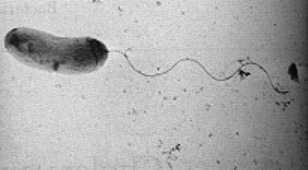Vibrio cholerae: Difference between revisions
imported>Zerla Lau No edit summary |
imported>Zerla Lau |
||
| Line 19: | Line 19: | ||
==Description and significance== | ==Description and significance== | ||
Vibrio Cholerae is a gram negative, curved rod-shaped bacterium that has a single polar flagellum. It is an aerobic organism and thrives best in alkaline mediums. The bacteria are most often found in aquatic environments such as marine habitats, water courses, wetlands, and lakes. | |||
==Genome structure== | ==Genome structure== | ||
Revision as of 20:19, 1 April 2008
Articles that lack this notice, including many Eduzendium ones, welcome your collaboration! |
Classification
Higher order taxa
Domain: Eubacteria
Phylum: Proteobacteria
Class: Gamma Proteobacteria
Order: Vibrionales
Family: Vibrionaceae
Species
Genus: Vibrio
Species: V. cholerae
Description and significance
Vibrio Cholerae is a gram negative, curved rod-shaped bacterium that has a single polar flagellum. It is an aerobic organism and thrives best in alkaline mediums. The bacteria are most often found in aquatic environments such as marine habitats, water courses, wetlands, and lakes.
Genome structure
Describe the size and content of the genome. How many chromosomes? Circular or linear? Other interesting features? What is known about its sequence? Does it have any plasmids? Are they important to the organism's lifestyle?
Cell structure and metabolism
Describe any interesting features and/or cell structures; how it gains energy; what important molecules it produces.
Ecology
Describe any interactions with other organisms (included eukaryotes), contributions to the environment, effect on environment, etc.
Pathology
Application to Biotechnology
Does this organism produce any useful compounds or enzymes? What are they and how are they used?
Current Research
Enter summaries of the most recent research here--at least three required
